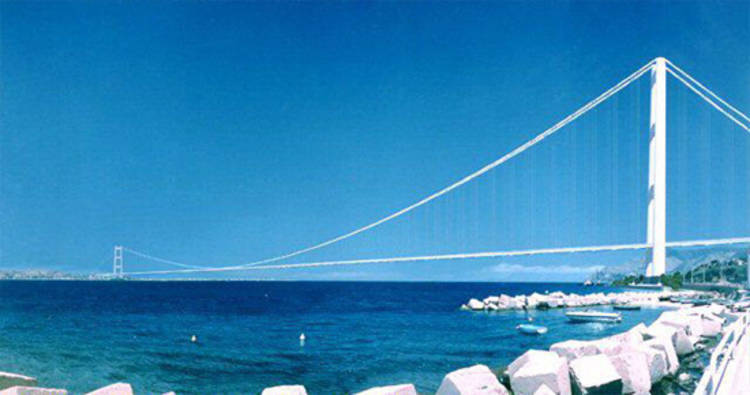


Pietro Ciucci, the newly-elected president of A.N.A.S (the Italian road-building agency), announced on May 23rd 2008 that the works for the building of the Messina Bridge, a 3,690-metre-long bridge designed to connect Sicily to the rest of the country, would recommence. For one reason or another the project was never implemented, but it has always been a source of great debates in the Italian Parliament between those who are favourable to its implementation and others who contest its utility.
The first to hypothesize the building of such an infrastructure was Charles the Great who, in the IX century, expressed his desire to build a bridge over the two opposite sides of the Tyrrhenian Sea. Then, two centuries later, a number of explorations of the Strait had been organized under the auspices of Ruggero II – King of Sicily – in order to ascertain the feasibility of such a project. But no financings were given to its implementation; so it was quickly shelved.
The project received new attention only in 1969 when A.N.A.S. organized an “International concourse of ideas” for the realization of a road and a railway that would connect Sicily to the rest of the Italian territory. The creation of the Strait of Messina Joint Stock Company in 1981 finally showed the concrete intention of the Italian government to realize what was conceived as a fundamental infrastructure for the economic renaissance of Sicily. This perception is still felt today for a number of reasons: first of all, the building of the project is meant to be a source of employment for more than 13.000 people; second, the project is conceived to be a great booster of local tourism, since it would facilitate the access to the island for tourists coming from the mainland. The same thing is true for Sicilian workers whose workplace is situated outside of the region: they would benefit from an infrastructure able to handle 4,500 cars an hour and 200 trains a day, which would substitute the slow ferry services existing nowadays. Last, but not least, the bridge would transform the Tyrrhenian Sea into an important trade route for the transportation of goods from Africa and the Middle East to the European Union. This especially from 2010 on, when the countries of the Northern and the Southern side of the Mediterranean Sea will be all involved in a Free Trade Area as part of a project aiming to deepen the economic and social links between them (The Euro-Mediterranean Partnership).
This perception is still felt today for a number of reasons: first of all, the building of the project is meant to be a source of employment for more than 13.000 people; second, the project is conceived to be a great booster of local tourism, since it would facilitate the access to the island for tourists coming from the mainland. The same thing is true for Sicilian workers whose workplace is situated outside of the region: they would benefit from an infrastructure able to handle 4,500 cars an hour and 200 trains a day, which would substitute the slow ferry services existing nowadays. Last, but not least, the bridge would transform the Tyrrhenian Sea into an important trade route for the transportation of goods from Africa and the Middle East to the European Union. This especially from 2010 on, when the countries of the Northern and the Southern side of the Mediterranean Sea will be all involved in a Free Trade Area as part of a project aiming to deepen the economic and social links between them (The Euro-Mediterranean Partnership).
Berlusconi, the new Italian Premier, has always adhered to these considerations since he himself pushed for the realization of the Bridge starting in his first mandate in 1994. During his first short-lasting government (he was in charge until 1996) and during the legislature he held from 2001 until 2006, the Left wing of Parliament has always opposed - the building of the Bridge.
Based on a number of studies performed by several Italian environmental NGOs, the Opposition stated that the Bridge would actually damage the region’s tourism sector, since its impact on the marine flora and fauna would be devastating. Moreover, concerns on a possible Mafia involvement in the implementation of the project were accompanied by another deep contestation: since its cost would be superior to 6.5 billion euro, they insisted that this sum could be better used to develop the industrial sector, giving Sicilian people greater job opportunities then they would have through the bridge’s construction since, once completed, 13.000 people employed for this purpose would be left without a job.
During Berlusconi’s mandates the total expenditures needed for studies and research concerning the Bridge reached a value of 600 million euro (if summed with the money previously spent). The end of his mandate in 2006 brought Prodi’s coalition to power. The then transportation minister Alessandro Bianchi, rejected the multi-billion-euro project, calling it ''the most useless and damaging project in Italy in the last 100 years''.
Berlusconi’s re-election seems to finally give him the chance to implement the project: Pietro Ciucci has stated that thanks to the Prime Minister’s determination and the financings devolved by the government, the construction of the Bridge could be over by 2016. If the centre-right coalition held by Berlusconi manages to stay in power until the deadline in 2013, no protests by the opposition or part of the civil society would be, at this point, able to stop construction and prohibit the completion of the biggest infrastructure Italy has financed in the last century.
Source URL: http://ftp.iitaly.org/magazine/focus/facts-stories/article/messina-bridge-odyssey
Links
[1] http://ftp.iitaly.org/files/messina1211740536jpg